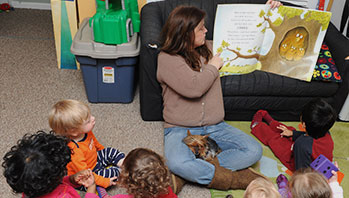- small suitcase
- fruit
- leaf
- pit
- seed
- suitcase
- travel
MA Standards:
Literature/RL.PK.MA.1: With prompting and support, ask and answer questions about a story or a poem read aloud.
Literature/RL.PK.MA.4: With prompting and support, ask and answer questions about unfamiliar words in a story or poem read aloud.
Literature/RL.PK.MA.10: Listen actively as an individual and as a member of a group to a variety of age-appropriate literature read aloud.
Head Start Outcomes:
Literacy Knowledge/Book Appreciation and Knowledge: Asks and answers questions and makes comments about print materials.
PreK Learning Guidelines:
English Language Arts/Reading and Literature 6: Listen to a wide variety of age appropriate literature read aloud.
English Language Arts/Reading and Literature 10: Engage actively in read-aloud activities by asking questions, offering ideas, predicting or retelling important parts of a story or informational book.
Read Together: A Fruit Is a Suitcase for Seeds #2

© Commonwealth of Massachusetts, Department of Early Education and Care (Jennifer Waddell photographer). All rights reserved.
STEM Key Concepts: Many foods that animals, including humans, eat come from plants; We eat certain leaves, roots, fruits, and seeds; Fruits have seeds; Seeds hold what a plant needs to make more of itself
ELA Focus Skills: Active Listening, Concepts of Print, Making Connections, Parts of a Book, Story Comprehension, Vocabulary
Before You Read
Show children the cover of the book. Ask a volunteer to point to the title; then read it aloud with children. Have children point to the names of the author and illustrator as you read them.
Set a listening focus for children by having them notice all the different ways a seed can travel from one place to another, so they will understand why some plants grow in places even though no one planted seeds there. Ask children to predict how seeds travel from the plant to other places. Say, Turn and tell your partner. Now, let’s read and see if you are right!
As You Read
Read slowly and with expression. Pause to talk about the illustrations and to read the names of the plants shown.
- Focus on the small drawings at the bottom of the pages. Help children see the connection to the large illustrations. For example, on the page that says, “Some seeds travel by water,” point to the man in the boat and say, Boats and seeds can both travel by water.
- Talk about how some people in the small pictures along the bottom have one suitcase and others have many. Equate this to different fruits having different numbers of seeds.
- Read the last spread (the girl eating a strawberry) and ask, Why do you think the author says the girl is really eating a suitcase? After children respond, point to the bird with a suitcase made to look like a strawberry. Read the tag, fruitcase, and guide children to understand that it is a made-up word. Explain that the illustrator made up the word to help the reader understand that the fruit is the case that holds and protects the seeds.
After You Read
Review the information from the book. Ask questions such as,
- What do you think the rabbit is going to do with the pea pod it has in its mouth?
- How do you think the seeds get to the water? How do you think seeds travel on the water?
Take It Further: Let children practice picture reading and description. Choose a detail in one of the book’s illustrations to describe. For example, look at the page about corn and say, I see something very tiny. It is red. Can you find it? Ask a volunteer to point to the detail you described and identify it. (bug) Let children take turns selecting pictures and describing details for classmates to find.
